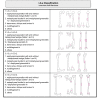Development and validation of a paediatric long-bone fracture classification. A prospective multicentre study in 13 European paediatric trauma centres
- PMID: 21548939
- PMCID: PMC3096600
- DOI: 10.1186/1471-2474-12-89
Development and validation of a paediatric long-bone fracture classification. A prospective multicentre study in 13 European paediatric trauma centres
Abstract
Background: The aim of this study was to develop a child-specific classification system for long bone fractures and to examine its reliability and validity on the basis of a prospective multicentre study.
Methods: Using the sequentially developed classification system, three samples of between 30 and 185 paediatric limb fractures from a pool of 2308 fractures documented in two multicenter studies were analysed in a blinded fashion by eight orthopaedic surgeons, on a total of 5 occasions. Intra- and interobserver reliability and accuracy were calculated.
Results: The reliability improved with successive simplification of the classification. The final version resulted in an overall interobserver agreement of κ = 0.71 with no significant difference between experienced and less experienced raters.
Conclusions: In conclusion, the evaluation of the newly proposed classification system resulted in a reliable and routinely applicable system, for which training in its proper use may further improve the reliability. It can be recommended as a useful tool for clinical practice and offers the option for developing treatment recommendations and outcome predictions in the future.
Figures





References
-
- Garbuz DS, Masri BA, Esdaile J, Duncan CP. Classification systems in orthopaedics. J Am Acad Orthop Surg. 2002;10(4):290–297. - PubMed
-
- Audige L, Bhandari M, Hanson B, Kellam J. A concept for the validation of fracture classifications. J Orthop Trauma. 2005;19(6):401–406. - PubMed
-
- Cohen J. A coefficient of agreement for nominal scales. Educational and Psychological Measurement. 1960;20:37–46. doi: 10.1177/001316446002000104. - DOI

